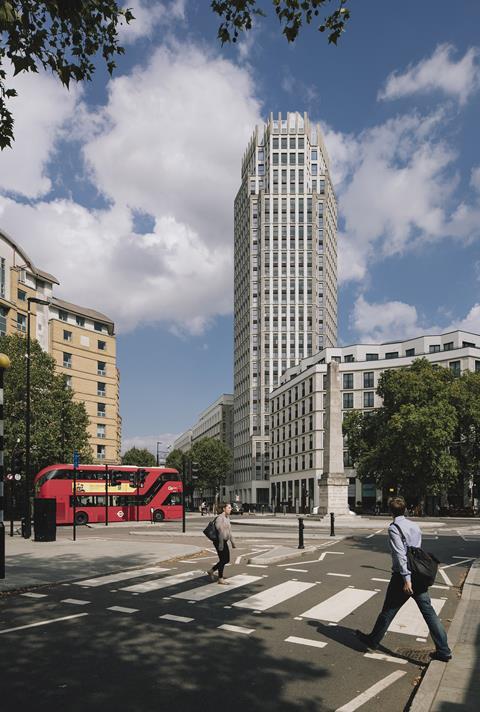Ben Flatman asks why London’s masonry vernacular has been ignored by so many of its tall buildings

Last month Bill de Blasio announced that New York is going “to ban the glass and steel skyscrapers that have contributed so much to global warming”. Even though it turned out the mayor’s “ban” was actually more of a polite nudge towards sustainable construction, the news reports made me ponder what a prohibition on glass curtain walling might mean for London. What would happen if architects designing here were also challenged to think differently?
Putting aside any fundamental objections to the explosion of tall buildings in the capital, it appears that the London skyscraper as a typology is stuck in a conceptual rut. Because there is no strong British history of building tall, we seem to lack the imagination or confidence to define our own tradition. Unarticulated glass cladding dominates. For decades now it seems that few British architects have been able to conceive of a tall building in any other material.
The City of London’s incoherent eruption of glass is the prime example of where it’s all going wrong, but the depressing consequences of this approach can be seen across the capital. The precedents for how to do things differently are already out there. London has developed its own convincing contemporary vernacular over recent years, based on a careful articulation of fenestration and real sensitivity to context and materials. But for some reason this hasn’t translated over into the city’s new high-rise architecture.
Perhaps Mies’ Berlin Friedrichstrasse scheme still exerts an undue influence. Ever since he ushered in the idea of the crystalline glass tower block, many architects have been in thrall to a particular concept of what a skyscraper should be. Too many computer renderings almost invariably depict any new high-rise proposal as a glistening, semi-transparent homage to that 1921 vision in glass.
In a London context this seems very odd. The city’s earliest high rises and its wider vernacular point in a completely different direction. Charles Holden’s 55 Broadway and Senate House were two of the earliest modern buildings to break the old London height restrictions and nodded towards art deco and the tapering New York skyscrapers of the Twenties and Thirties. Both were clad in Portland stone, conveying a sense of almost monolithic permanence.
>> Also read: London’s first skyscraper has its listing upgraded
Senate House in particular has long been divisive and was an early indicator of how many architects would find it difficult to design tall buildings convincingly for London. When setting the brief William Beveridge, the then vice-chancellor, specified that Senate House would be a building that “can only be at home in London”. To what extent Holden succeeded is debatable, but Eric Mendelsohn was convinced “that there is no finer building in London”.

A later rash of high-rise council housing, such as Rosemary Stjernstedt’s Alton Estate and Erno Goldfinger’s Trellick Tower pointed in another direction by embracing concrete, and a more Corbusian sensibility. The point being that tall buildings in London don’t need to be clad solely in glass.
The argument about whether London should be a high-rise city at all seems already to have been lost. The debate, as far as it ever took place, has been superseded by facts on the ground and towers on the skyline. The more urgent question now is not whether we should have skyscrapers in London, but what form should they take? Can we break from the tired aesthetic imposed by a hundred-year-old sketch and model by one of modernism’s founding fathers and imagine a way of building tall that is for and of London?
>> Aso read: Building Study: Blackfriars Circus, London, by Maccreanor Lavington
There are signs of hope. Maccreanor Lavington’s Blackfriars Circus is arguably the most successful recent attempt to meld the new vernacular with a specifically London high-rise form. It has a refreshingly un-trendy properly articulated “top” to its tower, and just as importantly engages as much with the street as it does with the skyline. Doubtless other architects are paying attention and hopefully they will respond in interesting new ways. Perhaps Maccreanor Lavington haven’t totally cracked how to build high in London, but they have at least shown that it’s not all about glass.
















4 Readers' comments